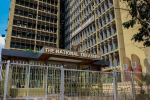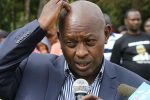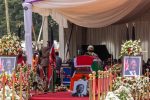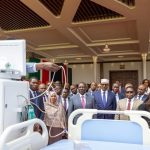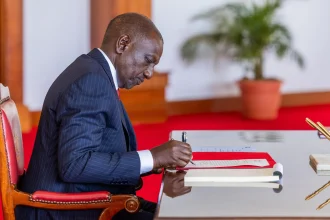President William Ruto and ODM leader Raila Odinga on Wednesday announced a team to coordinate the implementation of their 10-point “handshake” agenda.
The move comes following concerns within ODM that the “handshake” that brought together the broadbased government was putting the party at loggerheads with the public.
On March 7, 2025, the historic Memorandum of Understanding (MoU) was signed between Ruto’s UDA and Raila’s ODM)l, marking a significant shift in Kenya’s political landscape.
The agreement, formalised at the Kenyatta International Convention Centre (KICC) in Nairobi, outlined a 10-point agenda aimed at fostering national unity, addressing systemic governance challenges, and implementing the recommendations of the National Dialogue Committee (NADCO) report.
As the two seek to review and fast-track the implementation of the MOU, the Kenya Daily Chronicle has been evaluating the progress made on the 10-point agenda, drawing from recent developments, public sentiment, and official statements, including the establishment of a five-member oversight committee announced on August 6, 2025.
While the formation of the oversight committee is a promising step, the lack of tangible outcomes on key issues like youth unemployment, devolution, and human rights has fuelled public skepticism on the deal.
Background: A Nation at a Crossroads
The Ruto-Odinga MoU emerged in response to a tumultuous period in Kenya’s recent history.
The 2024 Gen Z protests, sparked by dissatisfaction with the Finance Bill, high cost of living, and governance failures, had brought the country to the brink of civil unrest.
Raila revealed that former President Uhuru Kenyatta urged him to engage Ruto to prevent Kenya from descending into chaos akin to Somalia or Haiti.
The NADCO report, produced in November 2023 following post-election tensions in 2022, served as the foundation for the MoU, advocating for reforms such as electoral justice, devolution, and the creation of new political offices like the Prime Minister and Leader of the Official Opposition.
The 10-point agenda includes commitments to:
1. Full implementation of the NADCO report
2. Inclusivity in public life
3. Strengthening devolution
4. Promoting youth livelihoods
5. Upholding leadership and integrity
6. Safeguarding the right to peaceful assembly and compensating protest victims
7. Addressing national debt
8. Fighting corruption
9. Stopping wastage of public resources
10. Promoting constitutionalism and the rule of law
Five months after the MoU’s signing, the formation of a five-member committee—comprising Gabriel Oguda, Agnes Zani, Kevin Kiarie, Fatuma Ibrahim, and Javas Bigambo—signals a renewed push to actualise these commitments
However, progress has been uneven, and public skepticism remains high, fuelled by internal ODM divisions, allegations of human rights abuses, and unfulfilled promises.
Implementation of the NADCO Report
The NADCO report, co-chaired by Wiper leader Kalonzo Musyoka and National Assembly Majority Leader Kimani Ichung’wah, proposed sweeping reforms, including restructuring the Independent Electoral and Boundaries Commission (IEBC), extending Supreme Court petition timelines, and increasing county revenue allocations.
While the report was tabled and passed in Parliament, its implementation has been slow. Raila has repeatedly emphasised that the report’s full execution is non-negotiable for ODM’s continued cooperation with Kenya Kwanza, citing its relevance to addressing youth grievances like electoral justice and cost of living.
However, critics, including Busia Senator Okiya Omtatah, have dismissed the report as a distraction from implementing the 2010 Constitution fully.
As it stands, only the reconstitution of the IEBC has been achieved but no other electoral reforms are in place even as political activity towards the 2027 elections increases.
As of August 2025, no significant legislative or structural reforms tied to NADCO have been reported, raising doubts about the feasibility of implementation with only 886 days until the 2027 elections.
Inclusivity in Public Life
The MoU promised equitable budgetary allocations and public appointments across Kenya’s diverse ethnic, religious, and geographic spectrum.
The inclusion of ODM members in Ruto’s cabinet, described as “ODM experts,” and the appointment of figures like Kagwe, Kabogo, and Kinyanjui, suggest efforts toward inclusivity.
However, critics argue that these appointments primarily serve political elites rather than ordinary Kenyans.
A TIFA survey from May 28, 2025, revealed that 46 per cent of Kenyans expect Raila to abandon the broad-based government by 2027, indicating public skepticism about the inclusivity narrative.
The perception that appointments reward political loyalty rather than merit persists, undermining the agenda’s credibility.
Strengthening Devolution
Devolution, a cornerstone of the 2010 Constitution, was a key focus of the MoU. ODM has pushed for increased county funding, advocating for a minimum of Sh450 billion compared to the current Sh415 billion allocation.
While the Treasury’s increase from previous figures was acknowledged, ODM maintains it is insufficient. The party also demands the full unbundling of devolved functions, arguing that counties lack the resources to succeed.
Despite these calls, there has been little progress in disbursing funds on time or devolving additional functions, frustrating county governments and local communities.
Promoting Youth Livelihoods
The 2024 Gen Z protests underscored youth unemployment as a national crisis. The MoU promised massive investments in sectors like mining, agriculture, and ICT to create jobs. However, tangible outcomes remain elusive.
The unemployment rate among young people remains alarmingly high, with limited access to capital, mentorship, and skill development.
ODM’s call for an inter-generational national conference to address youth challenges has gained traction, but no concrete plans have materialised.
The lack of progress has fuelled public discontent, with many young Kenyans viewing the MoU as empty rhetoric.
Leadership and Integrity
Chapter 6 of the 2010 Constitution emphasises integrity in leadership, a principle the MoU seeks to reinforce through stronger accountability mechanisms.
However, the fight against corruption has faltered. Reports indicate that anti-corruption efforts have taken a “serious beating,” with institutions like the Ethics and Anti-Corruption Commission lacking the capacity to deliver results.
Public perception, as reflected in media analyses, suggests that the political elite’s commitment to integrity remains superficial, with appointments of allies to key positions raising questions about impartiality.
Right to Peaceful Assembly and Compensation
The right to peaceful assembly, guaranteed under Article 37, has been a contentious issue, particularly during protests against government policies.
The MoU promised to safeguard this right and compensate victims of police brutality from the 2024 protests. Raila has insisted that contingency funds exist for compensation, but no payments have been reported as of August 2025.
Allegations of extra-judicial killings, abductions, and unlawful detentions continue to plague the Ruto administration, drawing criticism from ODM leaders like Edwin Sifuna.
The failure to address these human rights violations has placed the MoU under intense scrutiny.
National Debt
Kenya’s public debt, estimated at KSh11.5 trillion, was a focal point of the MoU, which called for an audit of past borrowings and accountability for future loans.
While the agreement emphasised equitable benefits from borrowed funds, no audit has been publicly reported, and debt management remains opaque.
Public discontent over burdensome taxation persists, with little evidence of progress toward transparency in public finance management.
Fighting Corruption
The MoU’s commitment to “winning the war against corruption” has seen limited success.
The pilferage of public resources at national and county levels remains a significant challenge.
While the agreement proposed enhancing the capacity of institutions like the Auditor General and Controller of Budget, no significant reforms have been implemented.
Public frustration with corruption continues to erode trust in the broad-based government.
Stopping Wastage of Public Resources
The MoU aimed to promote government efficiency by curbing opulence and resource wastage.
However, reports of government extravagance persist, and no specific measures to enhance efficiency have been publicised.
The lack of transparency in resource allocation has fuelled perceptions that the MoU is more about political posturing than substantive reform.
Constitutionalism and Rule of Law
The commitment to constitutionalism and the rule of law has been undermined by ongoing human rights concerns and attacks on judicial independence.
The Ruto administration’s criticism of the Judiciary over rulings against its programs has raised alarms, with legal experts like Steve Ogolla cautioning that the MoU’s success hinges on genuine political will.
The absence of concrete actions to protect constitutional freedoms has deepened public skepticism.
The Oversight Committee: A Step Forward?
The formation of the five-member committee on August 6, 2025, is a significant development, signalling a structured approach to monitoring the “handshake”’s implementation.
The committee, supported by a joint UDA-ODM secretariat, is tasked with submitting progress reports every two months and a comprehensive report by March 7, 2026.
The inclusion of figures like Gabriel Oguda, a prominent columnist, and Agnes Zani, a respected academic, suggests an attempt to bring diverse perspectives to the table.
However, the committee’s effectiveness remains to be seen, particularly given the tight timeline and the complexity of the reforms proposed.
The MoU has sparked significant divisions within ODM, with leaders like Edwin Sifuna expressing skepticism about the broad-based government’s commitment to the 10-point agenda.
Sifuna’s public criticism of human rights abuses and the slow pace of implementation led to tensions, with allies like Gladys Wanga and Junet Mohamed defending the pact.
Raila’s intervention to broker unity, as seen in the July 29, 2025, Central Committee meeting, underscores the delicate balance he must maintain to sustain the alliance.
The upcoming ODM National Delegates Convention in October 2025 will be a critical test of the party’s cohesion and its strategy for 2027.
Public sentiment, as captured in media reports and surveys, reflects growing disillusionment with the Ruto-Odinga pact.
The TIFA survey indicates that nearly half of Kenyans expect Raila to abandon Ruto by 2027, either to run for president or support another candidate.
The perception that the MoU is an “elite political settlement” rather than a people-centered reform effort has gained traction, with commentators arguing that it prioritises self-preservation over progress.
The Gen Z movement, which continues to demand accountability, remains a wildcard, potentially shaping the political landscape ahead of the 2027 elections.
